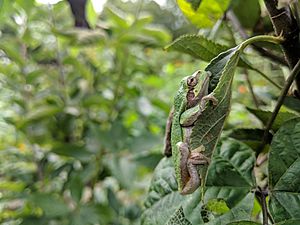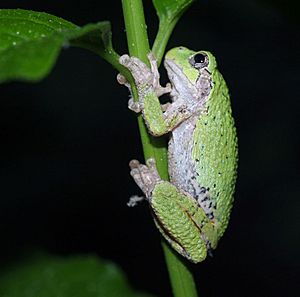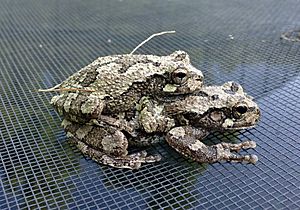Gray treefrog facts for kids
Quick facts for kids Gray treefrog |
|
|---|---|
 |
|
| Conservation status | |
| Scientific classification | |
| Synonyms | |
|
Hyla versicolor LeConte, 1825 |
The gray treefrog (Dryophytes versicolor) is a small species of tree frog. It lives in trees and is found in much of the eastern United States and southeastern Canada.
People sometimes call it the eastern gray treefrog or northern gray treefrog. This helps tell it apart from its close relative, Cope's gray treefrog.
Contents
Amazing Appearance and Camouflage
Gray treefrogs are masters of disguise! They can change their color to match their surroundings. This helps them hide from predators. They can turn gray, green, or brown. They can even change from almost black to nearly white. But they don't change as fast as a chameleon.
A cool thing about these frogs is their legs. They have dark bands that stand out against bright yellow or orange patches. These bright colors are usually hidden. They only show when the frog jumps.
You can tell male and female gray treefrogs apart by their throats. Females have white throats and do not call. Males have black, gray, or brown throats during breeding season. They are also the ones that make calls. Females are usually a bit bigger than males.
These frogs are fairly small. They usually grow to be about 1.5 to 2 inches (3.8 to 5.1 cm) long. Their skin looks lumpy, almost like it has warts.
Gray Treefrog vs. Cope's Gray Treefrog
It's hard to tell the gray treefrog apart from Cope's gray treefrog just by looking. The main difference is their call. Cope's gray treefrog has a shorter, faster call.
You can tell them apart by counting the pulses in their calls. The gray treefrog has 16 to 34 pulses per second. Cope's gray treefrog has 34 to 60 pulses per second. The speed of their calls changes with temperature. But at the same temperature, the gray treefrog's call is about half as fast as Cope's.
There's another big difference: their chromosomes. Gray treefrogs have 48 chromosomes. Scientists call them "tetraploid" because of this. Cope's gray treefrog has 24 chromosomes. It is called "diploid."
Tadpoles and Young Frogs
Gray treefrog tadpoles have round bodies. Their tails are high and wide. If there are predators nearby, their tails can turn red. Young frogs can change into adults in about two months. When they first become frogs, they are almost always green for a day or two. Then they change to the more common gray color. Some young frogs stay light green until they are adults.
Where Gray Treefrogs Live
Gray treefrogs live in many places. You can find them in most of the eastern United States. They live as far west as central Texas and Oklahoma. They also live in parts of Canada, including Quebec, Ontario, and Manitoba.
These frogs are very tough! They can survive even if their body fluids freeze. They can handle temperatures as low as -8 °C (17.6 °F).
Gray treefrogs mostly live in forests. They spend a lot of time high up in trees. You might hear their calls in neighborhoods in the East Coast and Midwest. They like to breed in woodland ponds that don't have fish. They also lay eggs in swamps, temporary pools, and even in water-filled swimming pool covers.
Behavior and Habits
These frogs usually stay high in the treetops. They only come down to breed. They are nocturnal, meaning they are active at night.
Male gray treefrogs are often solitary. They don't usually gather in large groups to call. But they might call more often during the busiest breeding times. You might see gray treefrogs near windows or porch lights. They go there to eat insects that are attracted to the light. During the day, they often rest on tree branches or leaves. They can even rest in the sun. Their amazing camouflage helps them hide from predators.
Reproduction and Life Cycle
Male gray treefrogs make mating calls mostly at night. But they will sometimes call during the day if they hear thunder or other loud noises.
Keeping Gray Treefrogs as Pets
If you want to keep a gray treefrog as a pet, their needs are similar to those of the American green treefrog.
Images for kids
See also
 In Spanish: Rana arbórea gris para niños
In Spanish: Rana arbórea gris para niños






